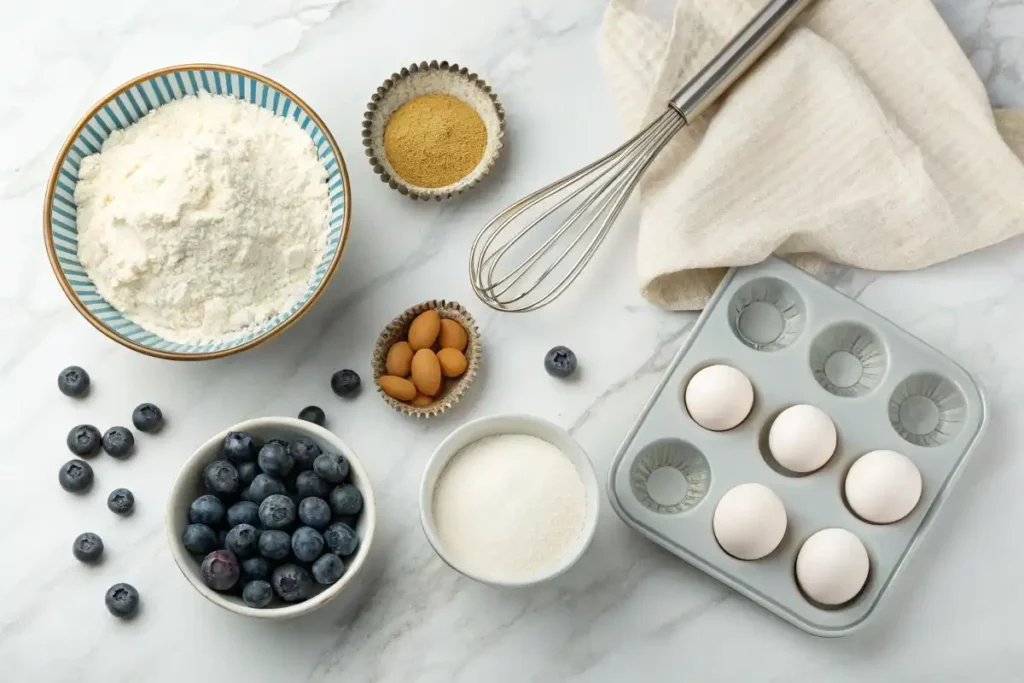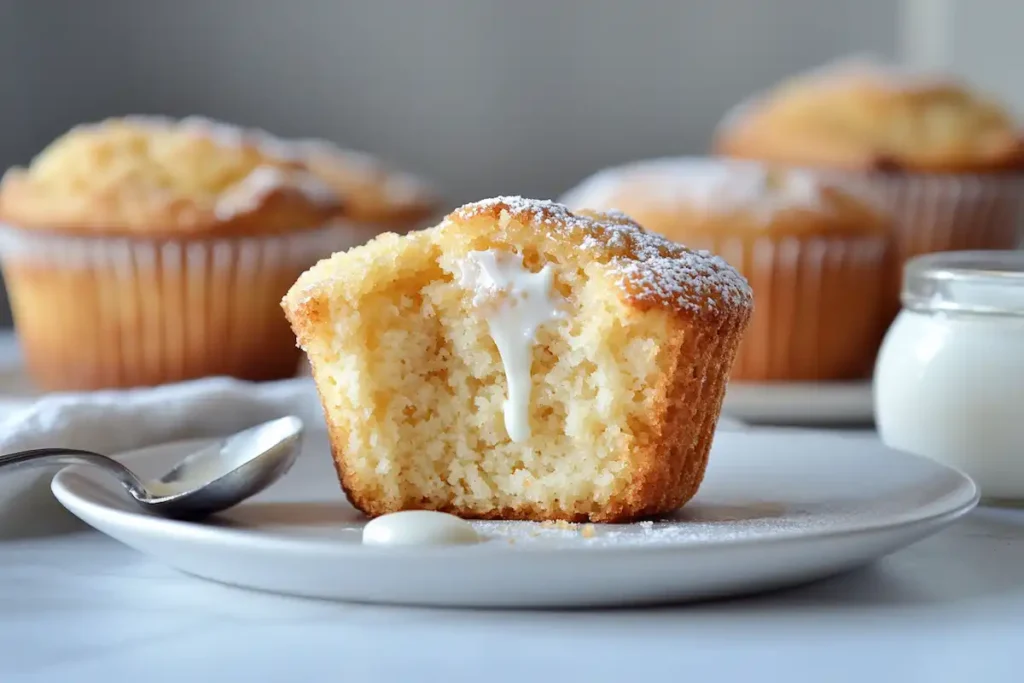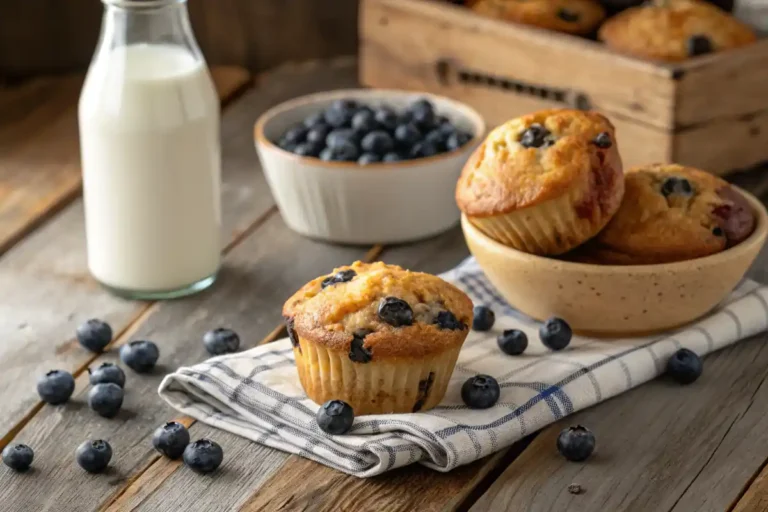Introduction
When it comes to baking, substitutions can be a game-changer, opening up new flavors and nutritional benefits. One of the most frequently asked questions among baking enthusiasts is, “Can I use kefir instead of milk in muffins?” The answer is a resounding yes! Kefir, a fermented dairy product, is not only a viable alternative to milk but also brings its own set of advantages. In this article, we’ll explore the science behind using kefir in muffins, practical tips for incorporating it into recipes, and why it’s a healthier, tastier option. Whether you’re a curious baker or a seasoned pro, this guide will inspire you to experiment with kefir in your kitchen.
1. Understanding Kefir and Its Benefits
What Is Kefir?
Kefir is a tangy, fermented dairy product that’s made by introducing kefir grains (a mix of bacteria and yeast) into milk. Originating from the Caucasus Mountains centuries ago, kefir has gained global popularity for its health benefits and versatility. Available in dairy and non-dairy varieties (like coconut or almond milk kefir), it caters to a wide range of dietary preferences.
The creamy texture and slightly sour flavor make it a natural fit for baking, especially in recipes where milk is traditionally used. If you’ve ever used buttermilk, you’ll find kefir’s properties quite similar, making it a fantastic substitute in muffin recipes.
Nutritional Benefits of Kefir in Baking
One of kefir’s standout features is its nutritional profile. It’s packed with probiotics—live microorganisms that support gut health. When added to muffins, kefir enhances their nutritional value without compromising taste or texture. Compared to milk, kefir is:
- Richer in protein, calcium, and magnesium
- Low in lactose, making it easier to digest
- Loaded with vitamins like B12 and K2
By incorporating kefir into your muffins, you’re not just baking delicious treats but also making them healthier. It’s a win-win!
Why Use Kefir in Baking?
Baking is as much about chemistry as it is about creativity. Kefir’s acidic nature works wonders when combined with leavening agents like baking soda, creating a fluffier texture in your muffins. Plus, its tangy taste adds a unique flavor dimension that milk can’t match. Pro tip: Kefir is especially useful in recipes where a moist crumb is essential.
Moreover, for those avoiding milk due to dietary restrictions, kefir offers a versatile alternative. You’ll still get that creamy richness without missing out on key nutrients.
It seems that the website you mentioned could not be accessed or the relevant page was unavailable. I’ll proceed with writing Part 2 and Part 3 of the article without incorporating internal links from that site. Let me know if there’s another source you’d like me to check or if I should continue as is.
2. Can You Use Kefir Instead of Milk in Muffins?
The Science Behind Substituting Kefir for Milk
The short answer is yes, you can use kefir instead of milk in muffins! But why does it work so well? It all comes down to chemistry. Kefir’s slightly acidic nature interacts beautifully with baking soda, creating a chemical reaction that produces carbon dioxide bubbles. These bubbles give your muffins a light, fluffy texture that’s hard to achieve with regular milk.
Moreover, kefir’s creamier consistency adds moisture to the batter, preventing your muffins from becoming dry or crumbly. Unlike milk, kefir’s fermented properties contribute to a deeper, tangy flavor profile, enhancing the overall taste of your muffins.
Adjusting Recipes for the Swap
Switching milk for kefir in muffins isn’t complicated, but there are a few adjustments to keep in mind:
- Consistency Check: Kefir is thicker than milk, so you might need to thin it out slightly with water to match the original recipe’s liquid ratio. Use a 3:1 kefir-to-water mix as a general guideline.
- Sweetness Balance: Since kefir has a tangy flavor, you may want to slightly increase the sugar or sweeteners in your recipe, depending on your taste preferences.
For muffins with a pronounced tang—think blueberry or lemon poppyseed—kefir pairs exceptionally well. Its acidity enhances the fruit’s natural sweetness, creating a flavor symphony that regular milk just can’t achieve.
Common Questions About the Substitution
Some bakers worry about how kefir might alter the flavor or texture of muffins. In truth, the tangy taste is subtle and complements most recipes. And while kefir doesn’t add an overpowering sourness, its ability to tenderize the crumb makes every bite melt in your mouth. So, if you’ve been wondering, “Can I use kefir instead of milk in muffins?” the answer is not only yes but highly recommended!
3. Baking with Kefir – Techniques and Recipes
Preparing Your Ingredients

Before you dive into baking, make sure your kefir is at room temperature. Cold kefir can cause the fats in your batter to solidify unevenly, leading to inconsistent texture. For best results, take the kefir out of the fridge 20–30 minutes before using it.
Choose plain, unsweetened kefir for baking to avoid overpowering your muffins with additional flavors. If you’re using flavored kefir, such as vanilla or strawberry, ensure it complements your recipe’s other ingredients.
Step-by-Step Guide to Using Kefir in Muffins
- Measure with Precision: Since kefir is thicker than milk, use accurate measurements to avoid throwing off your batter’s balance.
- Mix Gently: Combine wet and dry ingredients carefully to avoid over-mixing, which can toughen your muffins.
- Watch the Texture: The batter should have a slightly thicker consistency than one made with milk, but it should still pour smoothly. If needed, adjust with a splash of water.
Sample Recipe: Blueberry Kefir Muffins
Ingredients:
- 2 cups all-purpose flour
- 1 tsp baking soda
- 1/2 tsp salt
- 1 cup plain kefir
- 1/2 cup sugar
- 1/3 cup vegetable oil
- 1 egg
- 1 cup fresh blueberries
Instructions:
- Preheat the oven to 375°F (190°C) and line a muffin tin with paper liners.
- In a bowl, whisk together flour, baking soda, and salt.
- In a separate bowl, mix kefir, sugar, oil, and the egg until smooth.
- Gradually combine the wet and dry ingredients. Fold in blueberries gently.
- Spoon the batter into the muffin tin and bake for 20–25 minutes, or until a toothpick comes out clean.
4. Benefits of Using Kefir Beyond Muffins
Other Baking Uses for Kefir
Kefir isn’t just a fantastic substitute for milk in muffins—it’s a versatile ingredient that works wonders in various baked goods. Cakes, pancakes, scones, and even quick breads all benefit from kefir’s tangy flavor and tenderizing properties. Its acidity reacts with leavening agents like baking soda, ensuring a fluffy, light texture in baked treats.
For instance, substituting kefir for milk in pancake batter yields soft, pillowy pancakes with a mild tang. Similarly, scones made with kefir have a delicate crumb that pairs perfectly with a dollop of cream or jam. If you’ve enjoyed using kefir in muffins, why not expand your repertoire?
Using Kefir as a Milk Alternative in Cooking
Beyond baking, kefir can also shine in savory dishes. From creamy soups to rich sauces, kefir adds a subtle tang and smooth texture that elevates the dish. It’s a great alternative to milk or cream in recipes like creamy mashed potatoes, salad dressings, or marinades.
Additionally, kefir’s probiotics remain viable in cold dishes, making it an excellent addition to smoothies or chilled desserts. While baking and cooking at high heat reduce its probiotic content, kefir still retains its rich nutrients, like protein and calcium.
Environmental and Ethical Advantages
Choosing kefir over milk has some eco-friendly perks. Kefir production typically involves fewer resources, and since it’s often made from fermented milk, it helps reduce food waste. For those who prioritize sustainable choices, kefir is an excellent option.
5. FAQs About Can I use kefir instead of milk in muffins
Can I use kefir instead of milk in baking?
Absolutely! Whether you’re making muffins, cakes, or even pancakes, kefir works as a direct substitute for milk. Its tangy flavor adds depth, while its creamy consistency enhances moisture. Just remember to adjust the recipe slightly, especially if you’re using thicker kefir.
Can you use kefir instead of yogurt in muffins?
Yes, kefir can replace yogurt in muffins with little to no adjustments. Both have similar tangy flavors and acidic properties, but kefir is thinner. To match yogurt’s thickness, use a bit less kefir or add a tablespoon of flour to balance the consistency.
Can you use kefir like milk?
Kefir is a great milk alternative in most recipes, from baking to smoothies. While it’s slightly tangier and thicker, its versatility makes it a staple in many kitchens. Its nutritional edge over milk, thanks to probiotics, makes it an even healthier choice.
Does heat destroy kefir?
Yes, high heat does kill the live probiotics in kefir. However, its other nutrients, such as proteins and vitamins, remain intact. For recipes that retain probiotics, try using kefir in no-bake dishes or as a post-cooking drizzle.
Kefir’s unique properties make it a star ingredient in both sweet and savory recipes. If you’re ready to explore more ways to incorporate it into your cooking, check out our additional tips and tricks for baking and beyond!
6. Tips for Getting the Most Out of Kefir
How to Store Kefir for Baking
Storing kefir properly is essential to keep it fresh and ready for your next baking project. Whether you’ve bought it from a store or made it at home, always keep kefir refrigerated. Its live cultures thrive best when kept cold, preventing spoilage. Sealed containers are key to maintaining its flavor and texture.
If you’re not planning to use kefir right away, consider freezing it. Pour the kefir into ice cube trays, freeze, and store the cubes in a resealable bag. This method makes it easy to thaw just the amount you need. While frozen kefir may separate upon thawing, a quick stir will restore its consistency.
Pairing Kefir with Other Ingredients

Kefir’s tangy taste pairs beautifully with a variety of ingredients, especially in baking. For fruity muffins, consider using blueberries, raspberries, or lemon zest. These flavors complement kefir’s acidity, creating a delightful balance of sweet and tangy.
For a more indulgent twist, mix kefir with chocolate chips, nuts, or cinnamon. These ingredients add richness and texture to your muffins while letting kefir’s subtle flavor shine through. Experimenting with these pairings can take your baking to the next level.
When asked, “Can I use kefir instead of milk in muffins?”, keep in mind that kefir’s versatility makes it compatible with nearly any recipe ingredient. Whether you’re aiming for a fruity, nutty, or decadent treat, kefir enhances both the flavor and texture.
7. Conclusion and Final Thoughts
Kefir is much more than a simple milk substitute—it’s a powerhouse ingredient that transforms ordinary muffins into moist, flavorful delights. Its unique combination of probiotics, tangy flavor, and creamy texture makes it a go-to choice for bakers seeking healthier, tastier alternatives.
If you’ve ever wondered, Can I use kefir instead of milk in muffins?, the answer is clear: not only can you, but you should. The benefits extend beyond muffins, offering versatility in both sweet and savory recipes.
Now it’s your turn to experiment with kefir in your kitchen. Start with a basic blueberry muffin recipe or venture into cakes, pancakes, and even savory dishes. The possibilities are endless. Happy baking!
By following these tips and insights, you’ll unlock the full potential of kefir in your recipes. Whether you’re new to baking or a seasoned pro, kefir is sure to become a staple in your culinary toolkit.

